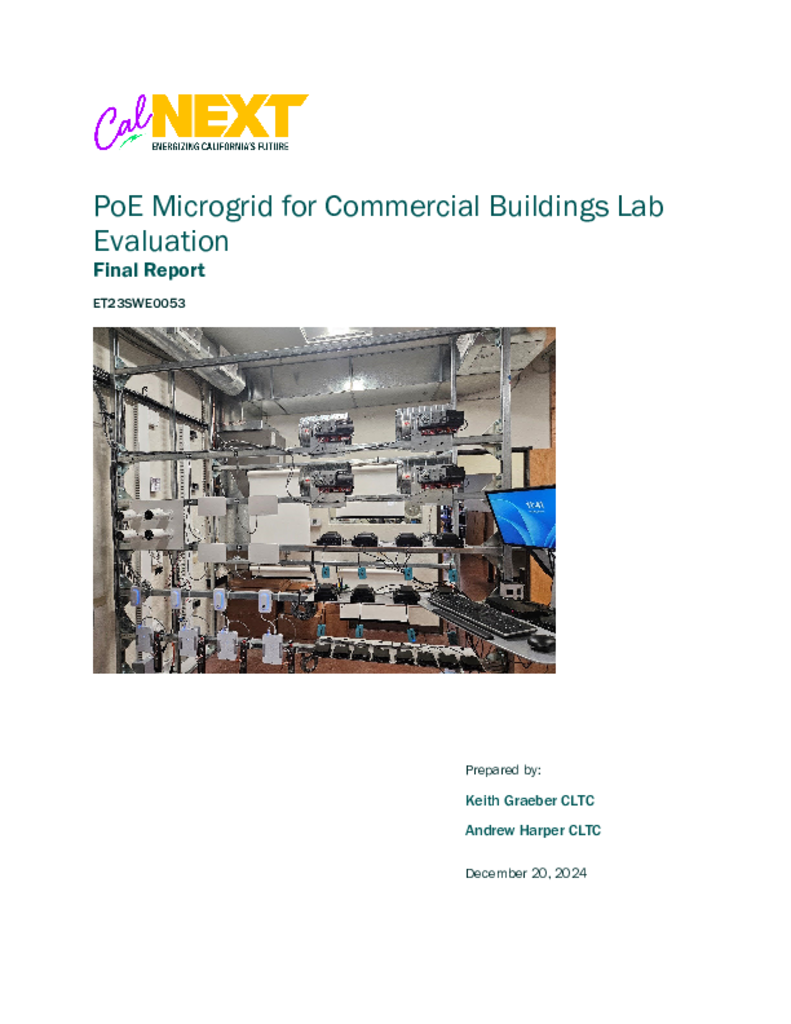ET22SWE0053 - PoE Microgrids for Commercial Buildings Lab Evaluation
The majority of building power distribution systems use alternating current (AC). This significantly influences the design of connected, building system components and appliances such as direct current (DC) appliances. With the proliferation of DC devices as standard design elements across many building technology categories, the interest in DC power distribution systems has also increased significantly. Power over Ethernet (PoE) leverages existing Information Technology (IT) infrastructure in the form of power switches, CAT cables and the IP protocol to facilitate communication and power distribution. Many control components across building systems, are being designed with PoE compatibility to save energy on the AC-to-DC conversion, facilitate networking, and reduce installation cost.
The PoE DC Microgrid project will evaluate the electrical efficiency and cybersecurity implications of utilizing a centralized PoE switch as the power and communications hub for multiple building systems in whole-building or floor-level microgrid. The project will first assess the electrical efficiency of a cross section of PoE enabled building control components relative to their traditional AC powered counterparts. PoE-enabled building systems that will be evaluated include: VAVs, security/physical access control systems, thin clients and networking components, lighting, shading and displays. Next, two scaled whole-building or floor-level PoE Microgrids will be designed using commercially available PoE-enabled building systems. The first system will utilize a separate, appropriately sized PoE switch for each building system and the second system will utilize a single, larger PoE switch to aggregate all building systems together. The research team will evaluate the electrical efficiency of each system as compared to each other and a baseline AC system. Finally, the research team will evaluate the cybersecurity measures that each PoE system manufacturer recommends regarding the installation, commissioning and network configuration for both PoE microgrid topologies. The research team will generate cybersecurity best practices for commissioning multiple PoE based building systems with a centralized PoE switch.
The purpose of this study is to evaluate the efficiency and cybersecurity of Power over Ethernet (PoE) building control systems compared with traditional AC-powered systems. As the adoption rates of PoE technology continues to grow across building automation systems, the study sought to assess the technical and operational performance of various PoE-enabled devices, providing insights into both their electrical efficiency and cybersecurity posture. The study's goals include identifying how PoE systems can streamline power and communication infrastructure in commercial buildings, while addressing any associated cybersecurity risks.
The team analyzed switch efficiencies across various load profiles, finding that efficiency generally increased as load on the switch increased, even though these efficiencies include some fluctuations at higher loads. For example, the PSE 2 achieved 49 percent efficiency at an 11 percent load, which improved to 83 percent at 91 percent load. However, certain switches, like the PSE 1, exhibited optimal efficiency within a mid-load range, with efficiency peaking at 79 percent at a 67 percent load before dropping to 69 percent at an 84 percent load. This suggests that while switch efficiency improves with increased load, it may plateau or decline as the switch approaches full capacity. These findings highlight the importance of managing switch loads to optimize system efficiency, particularly in PoE applications where power distribution can vary significantly based on the specific devices connected.
The study compared the efficiencies of centralized and decentralized PoE architectures, both of which utilized the same types and quantities of PoE devices. The results indicated that centralized systems, such as those using large switches like the PSE 3 and PSE 6, demonstrated significantly better efficiency, achieving 77-80 percent efficiency compared to 74 percent in decentralized systems. This performance advantage is largely attributed to the reduced overhead in centralized configurations, where a single large switch manages multiple loads more effectively. In centralized systems, the computational overhead required to manage PoE functionality is distributed across the entire load, minimizing its impact on overall efficiency.
The cybersecurity standards compliance evaluation further highlighted these shortcomings. Several devices, such as those from PoE Manufacturer 3 and 7, were found to be non-compliant with both SB 327 and UL/ANSI 2900, lacking encryption, authentication, and update mechanisms. Devices like PoE Camera showed partial compliance, offering strong encryption but failing in areas such as password management and resilience to malformed inputs. PoE Manufacturer 8 and 9 devices demonstrated the strongest compliance, with PoE Manufacturer 8 fully meeting SB 327 requirements and PoE PAC achieving full compliance with both standards. This analysis underscored the need for manufacturers to provide comprehensive cybersecurity guidance to ensure secure deployment of PoE systems, particularly in commercial environments where potential cyber threats could be significant.

